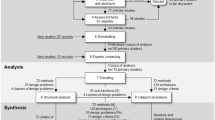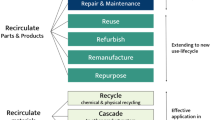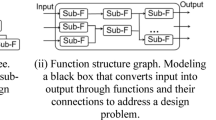Abstract
Computation techniques have provided designers with deeper understanding of the market niches that were neglected before. Usage contextual information has been studied in marketing research since the last century; however, little research in design engineering focuses on it. Therefore, in this paper, we analyzed the relations between usage context information and the design of products. A usage coverage model is established to integrate users and their expected usage scenarios into product family assessment. We map the user’s individual capacity together with a given product into the usage context space. The overlapping between the required usage and feasible usage can be measured. Based on this mechanism, several usage coverage indices are proposed to assess the compliance of a given product family to the expected set of usage scenarios to be covered. The original method is demonstrated on a scale-based product family of jigsaws in a redesign context. Constraint programming technique is applied to solve the physics-based causal loops that determine usage performances in a set-based design approach. Designers can rely on the results to eliminate redundant units in the family or modify the configuration of each product. The contribution of the paper is to provide an inter-disciplinary point of view to assessing the composition and configuration of a product family design.










Similar content being viewed by others
References
Alizon F, Shooter SB, Simpson TW (2007) Henry Ford and the model T: lessons for product platforming and mass customization. Paper presented at the ASME international design engineering technical conferences, Las Vegas, Nevada
Pine BJ (1993) Mass customization, the new frontier in business competition. Harvard Business School Press, Harvard
Tseng MM, Jiao J (2001) Mass customization. In: Handbook of industrial engineering, technology and operation management, 3 edn. Wiley, New York
Johnson C (2006) Who buys custom consumer products? Why custom product buyers could be your most important consumers. http://www.forrester.com/rb/Research/who_buys_custom_consumer_products/q/id/39664/t/2
Yannou B, Chen W, Wang J, Hoyle C, Drayer M, Rianantsoa N, Alizon F, Mathieu J-P (2009) Usage coverage model for choice modeling: principles. Paper presented at the ASME international design engineering technical conferences, San Diego, USA
Meyer MH, Lehnerd AP (1997) The power of product platforms: building value and cost leadership. The Free Press, New York
Green EP, Srinivasan V (1978) Conjoint analysis in consumer research: issues and outlook. J Consum Res 5:103–123
Srivastava RK (1981) Usage-situational influences on perceptions of product-markets: theoretical and empirical issues. Adv Consum Res 8:106–111
Belk RW (1974) An exploratory assessment of situational effects in buyer behavior. J Mark Res 11(May):156–163
Belk RW (1975) Situational variables and consumer behavior. J Consum Res 2(December):157–264
Ratneshwar S, Shocker AD (1991) Substitution in use and the role of usage context in product category structures. J Mark Res 28(3):281–295
Ratneshwar S, Warlop L (1993) The role of usage context in consumer choice: a problem-solving perspective. Adv Consum Res 20:377–382
Huffman C, Houston MJ (1993) Goal-oriented experiences and the development of knowledge. J Consum Res 20(2):190–207
He L, Hoyle C, Chen W, Yannou B, Wang J (2010) A framework for choice modelling in usage context-based design. Paper presented at the ASME international design engineering technical conferences, Montreal, Quebec, Canada, 15–18 August
Shih C-F, Venkatesh (2004) Beyond adoption: development and application of a use-diffusion model. J Mark 68(January):59–72
Hoffmann J, Roehrich G, Mathieu J-P (2006) The role of anticipation of usage and intention of usage in the evaluation of new product. Paper presented at the AFM conference, Nantes, France, 11, 12 May
Bergman E (2000) Information appliances and beyond: interaction design for consumer products. Academic Press, London
Michalek JJ, Feinberg FM, Papalambros PY (2005) Linking marketing and engineering product design decision via analytical target cascading. J Prod Innov Manage 22:42–62
Michalek JJ, Feinberg FM, Adiguzel F, Ebbes P, Papalambros PY (2008) Realizable product line design optimization: coordinating marketing and engineering models via analytical target cascading. Mark Sci
Reichenbacher T (2003) Adaptive methods for mobile cartograph. Paper presented at the 21st international cartographic conference, Durban, South Africa, 10–16 August
Green MG, Linsey JS, Seepersad CC, Wood KL (2006) Frontier design: a product usage context method. Paper presented at the ASME international design engineering technical conferences, Philadelphia, PA, USA
Green MG, Palani RPK, Wood KL (2004) Product usage context: improving customer needs gathering and design target setting. Paper presented at the ASME international design engineering technical conferences, Salt Lake City, UT, USA, 28 September–October 2
Green MG, Tan J, Linsey JS, Seepersad CC, Wood KL (2005) Effects of product usages context on consumer product preferences. Paper presented at the ASME international design engineering technical conferences, Long Beach, CA, USA
Yannou B, Wang J, Yvars P (2010) Simulation of the usage coverage of a given product. Paper presented at the international design conference—Design 2010, Dubrovnik, Croatia, 17–20 May
Thevenot HJ, Simpson TW (2006) Commonality indices for product family design: a detailed comparison. J Eng Des 17(2):99–119. doi:10.1080/09544820500275693
Alizon F, Shooter SB, Simpson TW (2006) Assessing and improving commonality and diversity within a product family. Paper presented at the ASME international design engineering technical conferences, Philadelphia, Pennsylvania, USA, 10–13 September
Thevenot HJ, Simpson TW (2007) A comprehensive metric for evaluating component commonality in a product family. J Eng Des 18(6):577–598. doi:10.1080/09544820601020014
Wassenaar HJ, Chen W (2003) An approach to decision-based design with discrete choice analysis for demand modeling. J Mech Des 125(3):490–497. doi:10.1115/1.1587156
Wassenaar HJ, Chen W, Cheng J, Sudjianto A (2005) Enhancing discrete choice demand modeling for decision-based design. J Mech Des 127(4):514–523. doi:10.1115/1.1897408
Kohli R, Sukumar R (1990) Heuristics for product line design using conjoint analysis. Manage Sci 36(12):1464–1478
Luo L (2010) Product line design for consumer durables: an integrated marketing and engineering approach. J Mark Res (forthcoming)
Balakrishnan PV, Gupta R, Jacob VS (2004) Development of hybrid genetic algorithms for product line designs. IEEE Trans Syst Man Cybern B 34(1):468–483. doi:10.1109/Tsmcb.2003.817051
Balakrishnan PV, Gupta R, Jacob VS (2005) An investigation of mating and population maintenance strategies in hybrid genetic heuristics for product line designs. Comput Oper Res 33(3):639–659. doi:10.1016/j.cor.2004.07.01
Belloni A, Freund R, Selove M, Simester D (2008) Optimizing product line design—efficient methods and comparisons. Manage Sci 54(9):1544–1552
Tsang E (1993) Foundations of constraint satisfaction. Academic Press, London
Benhamou F, Granvilliers L (2006) Continuous and interval constraints. Handbook of constraint programming. Elsevier, Amsterdam
Finch WW (1999) Set-based models of product platform design and manufacturing processes. Paper presented at the ASME international design engineering technical conferences, Las Vegas, USA
Ward AC, Liker JK, Sobek DK, Cristiano JJ (1994) Set-based concurrent engineering and Toyota. Paper presented at the ASME international design engineering technical conferences, Sacramento, CA
Wang J, Yannou B (2011) Explicit product family indicators based on a constraint programming simulation of usage coverage. Paper presented at the international conference on research into design, Bangalore, India, 10–12 January
ILOG (2001) ILOG Solver 5.4 User’s Manual. ILOG
He L, Chen W, Hoyle C, Yannou B (2012) Choice modeling for usage context-based design. J Mech Des. doi:10.1115/1.4005860
Berkowitz EN, Ginter JL, Talarzyk WW (1977) An investigation of the effects of specific usage situations on the prediction of consumer choice behavior. In: Greenberg BA, Bellenger DN (eds) Contemporary marketing thought: educators’ proceedings. American Marketing Association, Chicago, pp 90–94
Kotler P, Armstrong G (2009) Principles of marketing. Pearson Education International, Prentice Hall
Dickson P (1982) Person–situation: segmentation’s missing link. J Mark 46(4):56–64
Author information
Authors and Affiliations
Corresponding author
Appendix
Appendix
1.1 Jigsaw parameterization
See Fig. 11.
1.2 Intermediate variables for the jigsaw modeling
Intermediate variables (forces, speed) | |
|---|---|
ρ w (kg/m3) | Wood density |
μ (no unit) | Friction factor between steel and wood |
F t (N) | Translation force |
F t max (N) | Maximal translation force that can be delivered by the given user defined by C s vector |
F p (N) | Pressure force |
F p max (N) | Maximal pressure force that can be delivered by the given user defined by C s vector |
M w (N m) | Wrist torque |
M w max (N m) | Maximal wrist torque that can be delivered by the given user defined by C s vector |
F r (N) | Reaction force between slider and wood |
F f (N) | Friction force between slider and wood |
F a (N) | Advance force |
\( F_{{{\text{a}}_{i} }} \) (N) | Elementary advance force on tooth i |
F c (N) | Cut force |
\( F_{{{\text{c}}_{i} }} \) (N) | Elementary cut force on tooth i |
H d (m) | Height of scobs |
N m | Mean number of teeth cutting wood at any moment |
S c (m/s) | Mean cutting speed |
S c(t) (m/s) | Instantaneous cutting speed |
S a(t) (m/s) | Instantaneous advance speed |
1.3 Other relations for the jigsaw physics
1.3.1 Geometrical relations
In the upper position of the blade, the upper tooth is always above the slider and is expressed by:
The lower tooth in the upper position is below the lower wood stick plane (teeth are cutting all along the thickness at any moment of the cutting period):
The useful length of the blade L t, is proportional to step s and the number of teeth n − 1:
1.3.2 Static relations
All the forces are non-negative (by construction on Fig. 11) and the slider always touches the wood surface. Then:
The forces F t and F p delivered by the user onto the jigsaw tool can be modeled as intervals of possible values, which are bounded by the maximum allowable translation force F t max and pressure force F p max a user can afford:
As previously seen in Table 1, these maximal allowable bounds are dependent on the user gender and the user skill.
The horizontal force equilibrium (advance acceleration is neglected) is expressed by:
In the following, we assume that F t may be considered as a constant entry force, imposed by the user.
The friction force between the jigsaw slider and the wood is expressed by:
The vertical force equilibrium is expressed by:
The momentum equilibrium at the wrist position provides the expression of the wrist torque:
In the same manner, the torque in the user wrist M w is bounded by a maximal allowable torque the user may support expressed in Table 1.
The position of the reaction force of the slider must stay inside the slider surface area so as to avoid the jigsaw tool from flipping:
1.3.3 Cutting technological relations
The minimal teeth number for a successful cut is 3:
The mean number of teeth cutting wood at any moment is expressed by:
The elementary advance force \( F_{{\text{a}}_{i}} \) on a tooth i is provided by:
This equation means that \( F_{{\text{a}}_{i}} \) is constant. During the cutting phase, when the blade is ascending, a cutting relation exists between the elementary advance force F a(t) on a tooth i and the scob’s height H d(t). As \( F_{{\text{a}}_{i}} \) is constant, H d is constant when the blade ascends and the relation is:
This equation was found based on experimental measures of H d for different types of wood and teeth (i.e., different values of W t, ρ W, H d, α). The three A i coefficients have been found experimentally:
Finally, we obtain from (31) and (32) the following relation between H d and \( F_{{\text{a}}_{i}} \):
As well, a constraint should be:
During the descending phase, the scob’s height is zero:
The elementary cutting force on a tooth during the cutting—ascending—phase is:
This equation has also been found experimentally. In the same manner, the cutting force is not dependent on time.
During the descending phase, the cutting force is primarily due to the friction between the teeth and wood:
The resulting cut force is given by:
1.3.4 Kinematic relations
The mean cutting speed for a forth and back of the blade (i.e., A) is:
The instantaneous cutting speed has a sinusoidal form:
It can be inferred that the maximal cutting speed is:
The instantaneous advance speed during the descending phase is null:
The instantaneous advance speed during the cutting—descending—phase is (see similar triangles on Fig. 11):
The mean advance speed during one time period is:
During
we get
1.3.5 Power relations
During the cutting phase, the power provided by the engine and the hand must be enough to cut the wood, then:
Given that F t − F f − F a = 0 (advance acceleration neglected), then we obtain:
Consequently,
leading to:
Rights and permissions
About this article
Cite this article
Wang, J., Yannou, B., Alizon, F. et al. A usage coverage-based approach for assessing product family design. Engineering with Computers 29, 449–465 (2013). https://doi.org/10.1007/s00366-012-0262-1
Received:
Accepted:
Published:
Issue Date:
DOI: https://doi.org/10.1007/s00366-012-0262-1






